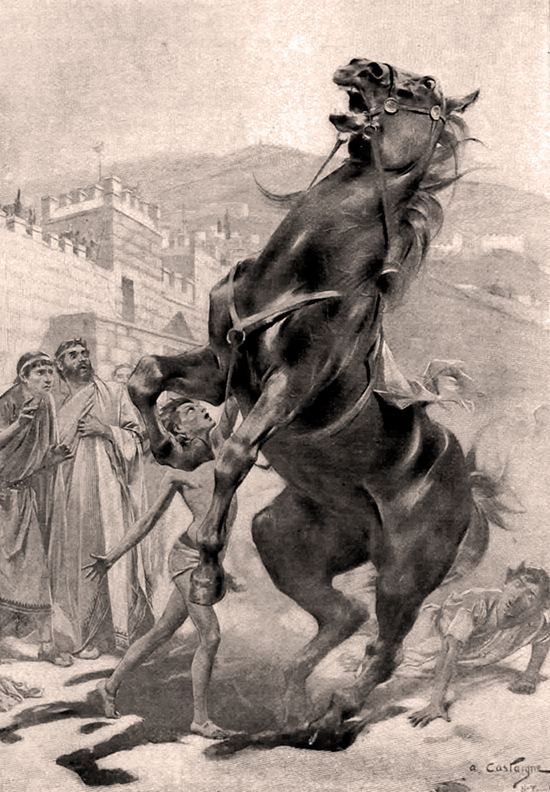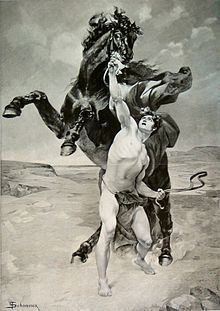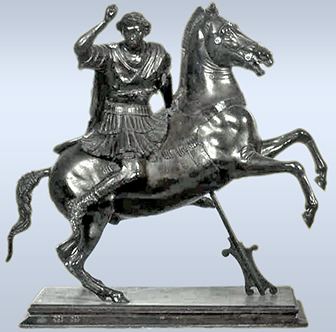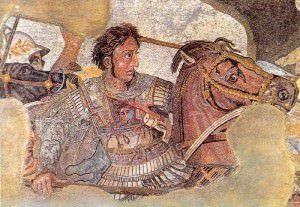Died June 326 BC | Species Equus caballus | |
 | ||
The black stallion bucephalus
Bucephalus or Bucephalas (/bjuːˈsɛfələs/; Ancient Greek: Βουκέφαλος or Βουκεφάλας, from βούς bous, "ox" and κεφαλή kephalē, "head" meaning "ox-head") (c. 355 BC – June 326 BC) was the horse of Alexander the Great, and one of the most famous actual horses of antiquity.
Contents
- The black stallion bucephalus
- Alexander horse bucephalus history bucephalus city latest facts hd
- The taming of Bucephalus
- Alexander and Bucephalus
- In art and literature
- References

Ancient accounts state that Bucephalus died after the Battle of the Hydaspes in 326 BC, in what is now modern Pakistan, and is buried in Jalalpur Sharif outside of Jhelum, Pakistan. Another account states that Bucephalus is buried in Phalia, a town in Pakistan's Mandi Bahauddin District, which is named after him.

Bucephalus was named after a branding mark depicting an ox's head on his haunch.
Alexander horse bucephalus history bucephalus city latest facts hd
The taming of Bucephalus

A massive creature with a massive head, Bucephalus is described as having a black coat with a large white star on his brow. He is also supposed to have had a "wall eye" (blue eye), and his breeding was that of the "best Thessalian strain." Plutarch tells the story of how, in 344 BC, at twelve or thirteen years of age, Alexander won the horse by making a wager with his father: A horse dealer named Philonicus the Thessalian offered Bucephalus to King Philip II for the remarkably high sum of 13 talents, but because no one could tame the animal, Philip was not interested. However, Alexander was, and he offered to pay himself should he fail to tame it.

Alexander was given a chance and surprised all by subduing it. He spoke soothingly to the horse and turned it towards the sun so that it could no longer see its own shadow, which had been the cause of its distress. Dropping his fluttering cloak as well, Alexander successfully tamed the horse. Plutarch says that the incident so impressed Philip that he told the boy, "O my son, look thee out a kingdom equal to and worthy of thyself, for Macedonia is too little for thee." Philip's speech strikes the only false note in the anecdote, according to AR Anderson, who noted his words as the embryo of the legend fully developed in the History of Alexander the Great I.15, 17.

The Alexander Romance presents a mythic variant of Bucephalus's origin. In this tale, the colt, whose heroic attributes surpassed even those of Pegasus, is bred and presented to Philip on his own estates. The mythic attributes of the animal are further reinforced in the romance by the Delphic Oracle who tells Philip that the destined king of the world will be the one who rides Bucephalus, a horse with the mark of the ox's head on his haunch.
Alexander and Bucephalus
As one of his chargers, Bucephalus served Alexander in numerous battles.

The value which Alexander placed on Bucephalus emulated his hero and supposed ancestor Achilles, who claimed that his horses were "known to excel all others—for they are immortal. Poseidon gave them to my father Peleus, who in his turn gave them to myself."
Arrian states, with Onesicritus as his source, that Bucephalus died at the age of thirty. Other sources, however, give as the cause of death not old age or weariness, but fatal injuries at the Battle of the Hydaspes (June 326 BC), in which Alexander's army defeated King Porus. Alexander promptly founded a city, Bucephala, in honour of his horse. It lay on the west bank of the Hydaspes river (modern-day Jhelum in Pakistan). The modern-day town of Jalalpur Sharif, outside Jhelum, is said to be where Bucephalus is buried.
The legend of Bucephalus grew in association with that of Alexander, beginning with the fiction that they were born simultaneously: some of the later versions of the Alexander Romance also synchronized the hour of their death. The pair forged a sort of cult in that, after them, it was all but expected of a conqueror that he have a favourite horse. Julius Caesar had one; so too did the eccentric Roman Emperor Caligula, who made a great fuss of his horse Incitatus, holding birthday parties for him, riding him while adorned with Alexander's breastplate, and planning to make him a consul.
In art and literature
Bucephalus is referenced in art and literature.
Paintings of Charles Le Brun's Alexandrine subjects, including Bucephalus, survive today in the Louvre. One in particular, The Passage of the Granicus, depicts the warhorse battling the difficulties of the steep muddy river banks, biting and kicking his foes.
One interpretation of the ancient statue group The Horse Tamers in the Piazza del Quirinale in Rome is "Alexander and Bucephalus".
